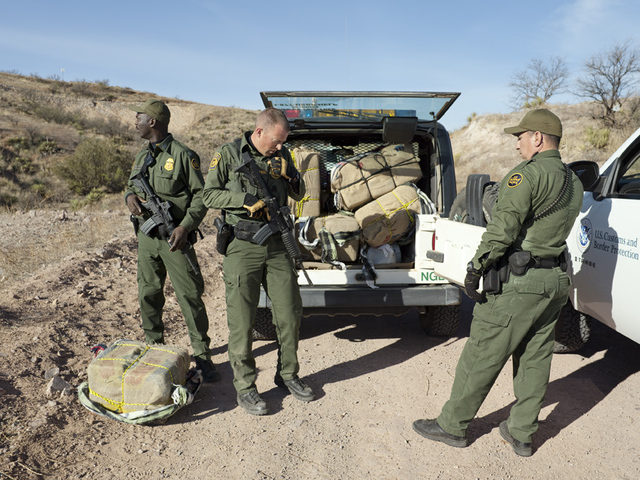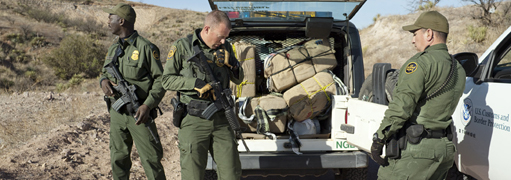When Paul Wells started working as a border patrol agent in Las Cruces 30 years ago, his station had a two-way radio and a telephone. "That was it," he says, and there were less than 2,000 agents nationwide. Over time, their numbers swelled, the funding surged and the technology was upgraded. There are around 20,000 agents in U.S. Customs and Border Protection. They’ve opened many more stations along the border. They can optically scan the fingerprints of every person who is apprehended and take a look at their criminal record within minutes. In 1995, Wells moved to Santa Teresa, N.M., to help open a new station. He estimates they would sometimes make more than 100 apprehensions a day. By the time he retired in January 2010, they were down to maybe five, and there were even days when there were none. The difference? The border patrol changed its strategy after 9/11, he says, to one of deterrence. Over the course of Wells’ career, he watched the United States gain control of the border. "We have built over 600 miles of fence," he says. Besides the fencing and the metal Xs of the vehicle barrier stretching across the Southwest, there’s another way to visualize "the line," as Wells calls it: obelisks. They are visible by line of sight. The obelisks stretch from Tijuana, Mexico / San Ysidro, Calif., to El Paso, Texas / Juárez, Mexico. Installed in the 1800s, most are cast iron and 6 feet tall. Some are 11-foot-tall masonry monuments. Two placards are mounted to each. The north side reads "Boundary of the United States of America," and south side, "Limite de la Republica Mexicana."There are 276. David Taylor began photographing them in 2006 and has so far shot all but 30. But the obelisks are just the organizing principal behind Taylor’s work. After years of spending time on the line, with and without border patrol agents, he’s got another aim in mind. "The project is ultimately about what the current disposition of the border is." Taylor and Wells both say they’d like to counteract the polarizing, political debate polluting the conversation around immigration and border security. Taylor holds more liberal views on the issues, and Wells sides with law enforcement. The two met when Wells first escorted Taylor, a photography professor at New Mexico State University, into the desert. They became friends over the years, and Wells even used his vacation time to accompany Taylor into a remote desert area. As they navigated the complexities of the line together, they found their views changing.The photographer says he was surprised by the people who make up the border patrol. "I met a lot of agents who were actually the kids of people who crossed the border illegally themselves." Big-time and small-time drug traffickers, immigrants looking for a better life, Minutemen, members of the Mexican army, Federales—Taylor ran into most of the characters one might expect to populate the border. For him, those interactions painted a picture with more depth than the two-dimensional token politicians brandish in stump speeches."From one vantage point," Taylor says, "we’re being invaded from the south, and we need to be shooting people at the border. And from the other vantage point, the border patrol are these sort of storm-trooper characters that beat up on people." He’d heard of "rockings," he says, situations where people hurl rocks when in a battle with the border patrol. He’d been around agents talking about using deadly force in those situations and imagined a David and Goliath scenario. "It’s like, Oh yeah, you really need to pull your gun out." One day, a car without plates was fleeing back to the border carrying bales of marijuana, Taylor says. The driver ditched his car at the fence and vaulted over the top while being Tased by a Nogales, Ariz. police officer. And then the rocking started. "This hail," Taylor remembers, "this hail of fist-sized to softball-sized rocks started coming over the border fence. When you saw them flying over, you had to wonder who was throwing them." Agents were pinned in their vehicles, and windshields were shattering, he says. "I was like, Oh. I get it now."Patrolling the border can be boring, Wells acknowledges. But long hours of nothing are sometimes punctuated with moments of danger. As the border is secured, he says, the smugglers grow frustrated. "They start to want to take it out on the agents patrolling. Violence went up with the increase in security." These days, the ratio of immigrants to drug smugglers has changed, Wells says. It used to be almost entirely immigrants the patrol dealt with, but as the deterrence strategy started to work, agents began seeing a higher percentage of criminals. Eight or nine months before Wells retired, his radio squawked about a young girl crossing near Monument 1. Once apprehended, she went into labor. She was only seven months along, and after treatment at a hospital, did not end up delivering the baby. She was transported back to Mexico still pregnant. A week later, Wells’ radio told him there was a young girl with a few guys coming across in the same area. "They’re actually out in the river, which even when the river’s low, can be a dangerous thing to do." Sure enough, it was the same pregnant girl. "Some cases pull your heart strings," he says. Plenty of Americans don’t contribute much to society, Wells says, "but a person like that who is obviously ambitious and strong-willed—you have to appreciate that."Wells and Taylor agree immigration reform is going to have to involve some combination of providing amnesty and legalization for people who are here, as well as further securing the border—not one or the other.As the immigration debate comes to a boil, Wells says, everyone needs to step back and tune out the people on the extremes of either side of the issue. "Cooler heads are going to have to prevail."
David Taylor, Paul Wells and other panelists talk about the borderThursday, July 15, 5:30 p.m. to 7:30 p.m.New Mexico History Museum Auditorium113 Lincoln, Santa FeFree(505) 476-5200, dtaylorphoto.comTaylor will sign copies of his book, Working the Line










